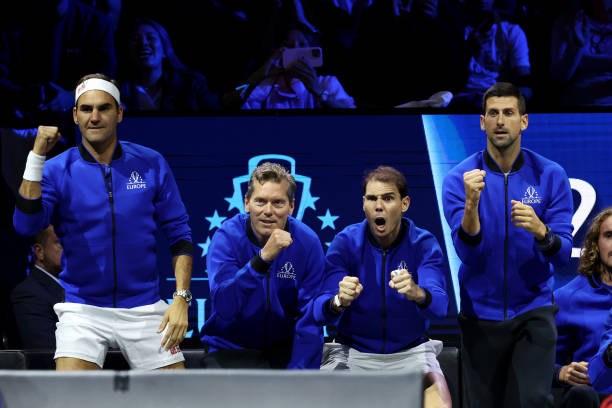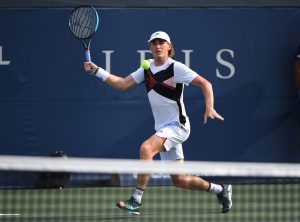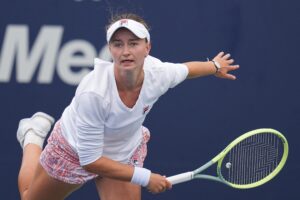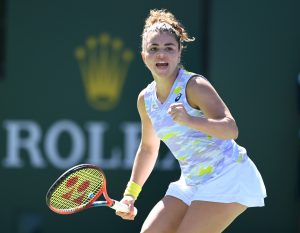Now that Roger Federer has finally retired from men’s tennis and the era of The Big Three (Federer, Rafael Nadal and Novak Djokovic) is officially over, what’s next for men’s tennis? Well, after an extraordinary weekend of indoor tennis in Vienna and Basel that has set the scene perfectly for the final Masters event of the year in Paris, all the signs are that The Big Three will be replaced by a remarkable battle between three different generations, in which Major-winners (and Major-contenders) who are divided in age by almost two decades will duke it out for the sport’s greatest prizes. And although this era will necessarily be much shorter-lived than that of The Big Three, it should still be spectacular.
The Old “Next Gen”
The first of the three different generations currently competing against each other is what might be called The Old “Next Gen” – the cohort of players in their mid-twenties who about 18 months ago were foreseen as being the most likely replacements for Federer, Nadal and Djokovic at the top of the game. They are spearheaded by Daniil Medvedev (aged 26), the only one among them to have won a Major so far, but they also include Stefanos Tsitsipas (aged 24) and Andrey Rublev (aged 25).
At the weekend, Medvedev reminded everyone just why he has pulled ahead of his peers of the same age. After something of a stop-start 2022, which included being banned (along with all other Russian and Belorusian players) from Wimbledon, he has failed to build on his spectacular 2021 US Open victory, when he stopped Novak Djokovic from winning the Calendar Slam at the very last hurdle. However, after becoming a father for the first time earlier this month, Medvedev celebrated by triumphing at the Erste Bank Open in Vienna in sumptuous style.
After relatively easily swatting aside Jannik Sinner and Grigor Dimitrov in the quarter-final and semi-final respectively, Medvedev faced a much harder contest in the final against Denis Shapovalov, who took the first set and matched Medvedev for much of the second set. That was until the Russian returned to his inspired, almost spidery best, by raising his game, extending those extraordinary limbs and returning balls that were seemingly impossible to get to. And after early problems with his serve in the first set, he also reminded everyone that at his finest he is the fastest, indeed the most rapid-fire, server since Federer at his best.
Medvedev has already won one Major, but having lost another three Major finals (including, of course, the Australian Open Final this year when he was two sets to love up against Rafael Nadal) he surely will not settle for that sole Slam triumph. If nothing else, he will want to win at least one more Major for his new daughter, as other new tennis fathers like Boris Becker have done in the past.
By contrast, it no longer seems certain that Tsitsipas and Rublev will win Majors or even contest for them in finals. Arguably, they have both plateaued over the last year or so, remaining in the top 10 but being surpassed by Carlos Alcaraz, both to a first Major and to the World No.1 spot. And with Alcaraz being joined by a number of other rising stars, it is possible that Tsitsipas and Rublev (along with Alexander Zverev when he finally returns from injury) will discover that, having waited so long for The Big Three to fade away, new stars are emerging to take their place. And those stars will come from the second generation of men’s tennis.
The New “Next Gen”
That second generation could be called the New Next Gen, as they have already largely overtaken the Old Next Gen. They are led, of course, by Carlos Alcaraz, who has been not only the breakthrough male player of 2022 but arguably the best male player of 2022 (Rafael Nadal’s two Major wins in Melbourne and Paris notwithstanding). Alcaraz has already won his first Major and ascended to World No.1 at the ridiculously young age of 19, making him the first teenager to reach those heights since his compatriot Nadal nearly two decades ago.
Like The Big Three before him, especially Federer, Alcaraz appears to be forcing all the other male players on tour, especially those in his own age range (late teens and early 20s), to raise their game if they are to have any chance of competing with him. That was already evident earlier this year in the outstanding wins against him in the finals in Hamburg and Croatia by Lorenzo Musetti and Jannik Sinner respectively. However, it is possible that Alcaraz’s major rival at the Majors from his own tennis generation will come from another quarter.
That direct rival might just be Felix Auger-Aliassime (aged 22), who has emerged almost as spectacularly this autumn on the indoor courts of Europe as Alcaraz himself did on the hard and clay courts of North America and Europe in the spring. After beating Holger Rune in straight sets in the final of the Basel Open, Auger-Aliassime has now won three titles in a row, having already triumphed in Florence and Antwerp. Even more importantly, he has effectively looked like a completely new player, never more so than in his semi-final victory over Alcaraz in Basel. If it wasn’t quite a beatdown, it was certainly a comprehensive straight-sets victory, as F2A beat the brilliant Spaniard for the second time in a row, having already got the better of him in Davis Cup action in September.
The Greatest Gen Of All
Of course what makes men’s tennis so uniquely tantalising at the moment is that two-thirds of The Big Three – Nadal and Djokovic – are still here and still competing for the biggest prizes in tennis: indeed, between them they won three of the four Majors this year (Djokovic triumphing at Wimbledon after Nadal’s victories in Australia and France). Although Nadal has typically had the second half of 2022 interrupted by injuries and Djokovic was banned from two of the four Majors this year because of his refusal to get vaccinated against Covid, the two remaining titans of men’s tennis remain the most difficult men to beat on the circuit, especially over five sets at the Majors.
They also both have huge goals still to go for. In addition to competing against each other to see who will end their career with the most Majors overall, next year (if he is allowed) Djokovic will go for a 10th Australian Open in Melbourne while Nadal will be competing for a scarcely believable 15th French Open in Paris. Those two statistics (or near-statistics) say it all about the enduring greatness of both Nadal and Djokovic, and they will not be easily replaced by any younger players.
An Unprecedented Three-Way Battle For Supremacy
To have four Major-winners (Nadal, Djokovic, Medvedev and Alcaraz) from three different generations, with other players from at least two of those generations (Tsitsipas, Rublev, Sinner, Musetti and Auger-Aliassime) also determined to make the step up at the Slams, is absolutely unprecedented in tennis history and indeed in sporting history in general. To have champions spanning a 17-year age range, from Nadal at 36 to Alcaraz at 19, has never happened before and it is arguable that it will never happen again, because the remarkable longevity of The Big Three (or The Big Two, as they now are) will not easily be replicated by any future generation.
Just to give an idea of how unusual this three-generational battle is, it’s worth comparing it to previous periods in men’s tennis history. Put simply, it would be as if Bjorn Borg had not retired in 1981 but instead kept playing for another 15 or 16 years, when he would have encountered a young Federer making his first steps in the professional game. Or to give another scenario from another sport, it would be as if Pele had kept playing internationally for Brazil into his late thirties and encountered the young Diego Maradona in one of his first ever internationals for Argentina.
These scenarios did not happen and for good reason: sport is an almost uniquely ruthless profession in which longevity of anything more than a few years is a rarity. To have, as men’s tennis has now, two veteran champions in Nadal and Djokovic who are still at or near their peak fighting it out with players not just a decade younger than them (such as Medvedev) but almost two decades younger than them (such as Alcaraz) is extraordinary. Indeed, in its own way it is just as extraordinary as the era of The Big Three, when the three greatest male players ever competed against each other for more than 15 years. Now the era of The Big Three has ended, but the era of The Three Generations has replaced it, beginning in Paris this week, when all the aforementioned players will be fighting it out against each other as Major-winners for the very first time.
Main Photo:






